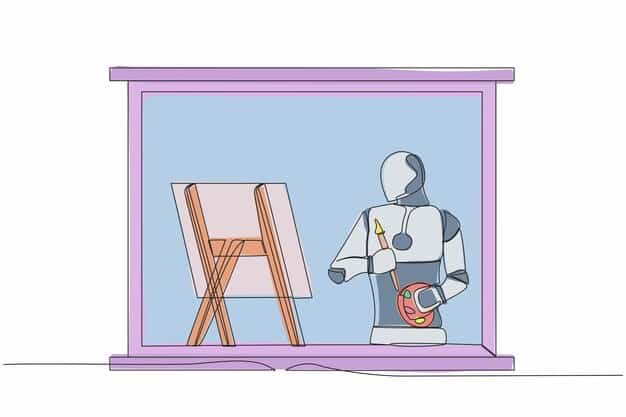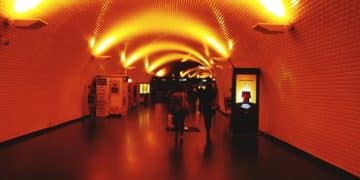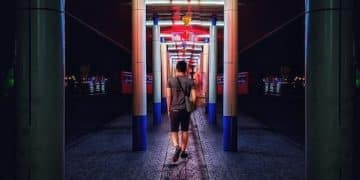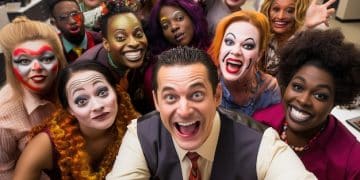The Evolution of Animation: From Hand-Drawn Classics to Cutting-Edge CGI

The evolution of animation encompasses a fascinating journey from the meticulous craftsmanship of hand-drawn classics to the dynamic, immersive worlds created by cutting-edge CGI, fundamentally transforming how stories are told and experienced across global entertainment.
Delving into The Evolution of Animation: From Hand-Drawn Classics to Cutting-Edge CGI reveals a narrative as captivating as the films themselves. From the early flicker of flipbooks to the seamless realism of digital rendering, animation has consistently pushed the boundaries of visual storytelling. This journey reflects not just technological advancements, but a profound artistic and cultural transformation that continues to redefine narrative possibilities on screen.
The Pioneering Years: Hand-Drawn Beginnings
The dawn of animation was a labor of love, a testament to human ingenuity and artistic dedication. Before the advent of computers, every frame, every movement, was meticulously crafted by hand, demanding immense precision and patience. These early pioneers laid the groundwork for an art form that would one day captivate billions, demonstrating that movement could be conjured from still images, bringing static drawings to life with incredible fluidity and expression.
Early animated films, often short and experimental, explored the basic principles of motion. Artists meticulously drew frame after frame, creating the illusion of movement when played in rapid succession. This process, known as traditional or cel animation, was central to the development of the art form, establishing fundamental principles that still resonate in modern animation techniques. The commitment to perfecting each drawing ensured that every gesture, every emotional nuance, was intentionally designed, providing a distinct aesthetic that continues to charm audiences worldwide.
Early Innovations and Techniques
The earliest forms of animation predated cinema itself, appearing in optical toys like the zoopraxiscope and praxinoscope. These devices used a series of images around a spinning cylinder or disk to create the illusion of movement. As cinema emerged, animators adapted these principles to film, drawing directly onto film strips or using cutout figures manipulated frame by frame. The advent of cel animation, however, marked a significant leap, streamlining the production process and allowing for more complex visuals.
- Cel Animation: Drawing and painting characters or objects on transparent celluloid sheets (cels) and then placing them over a painted background. This allowed for characters to move independently of the background, saving countless hours of redrawing.
- Rotoscoping: Invented by Max Fleischer, this technique involved tracing over live-action footage frame by frame, giving animated characters remarkably realistic movement.
- Stop-Motion: Manipulating physical objects or puppets incrementally and photographing each small change, creating movement when the frames are played consecutively.
The laborious nature of hand-drawn animation often meant that even short films took months, if not years, to produce. Teams of artists, inkers, and painters collaborated, each contributing to the intricate mosaic of moving images. This collaborative spirit, combined with the groundbreaking techniques developed, ensured that these early works were not just fleeting entertainments but foundational works of art that shaped the future of cinematic storytelling.
The pioneering years established animation as a legitimate art form, capable of expressing complex narratives and profound emotions. The dedication to craft, exemplified by hand-drawn classics, created a legacy of timeless characters and stories that continue to be celebrated for their artistic integrity and enduring appeal. These foundational techniques were crucial in defining the aesthetic and narrative potential of animation, setting the stage for future innovations.
The Golden Age of Animation: Disney’s Dominance and Beyond
The period from the 1930s to the 1950s is widely regarded as the Golden Age of Animation, a monumental era characterized by unparalleled artistic and technical innovation. Walt Disney Studios was a dominant force, elevating animation from short novelty cartoons to full-length narrative features that captured the hearts and imaginations of audiences worldwide. This era saw remarkable advancements in storytelling, character development, and animation techniques, demonstrating the medium’s capacity for profound artistic expression.
Disney’s pursuit of realism and emotional depth pushed the boundaries of what was thought possible in animation. Films like Snow White and the Seven Dwarfs (1937), the first full-length animated feature, were groundbreaking achievements, not only in their technical complexity but also in their ability to evoke deep emotional responses from viewers. The emphasis shifted from simple gags to complex narratives, with fully developed characters and intricate plotlines, solidifying animation’s place as a serious form of cinema.
Technical and Artistic Innovations
The Golden Age was defined by significant technical advancements that allowed for greater realism and immersion. The multiplane camera, developed by Disney, was a pivotal innovation, adding depth and dimension to traditionally flat animation. This allowed for more complex camera movements and a richer visual experience, mimicking the depth perceived in live-action film and drawing audiences further into the animated worlds.
- Multiplane Camera: This device uses multiple layers of artwork at different distances from the camera, allowing for dynamic perspective changes and the illusion of depth, significantly enhancing visual realism.
- Character Animation Principles: Disney animators codified principles like “squash and stretch,” “anticipation,” and “follow-through,” which became foundational for conveying realistic and expressive movement.
- Sound and Music Integration: Synchronized sound became an intrinsic part of the animation experience, with music often driving the narrative and emotional beats, setting a standard for musical features.
Beyond Disney, other studios also made significant contributions. Warner Bros. cartoons, with their distinct witty humor and iconic characters like Bugs Bunny and Daffy Duck, offered a more irreverent and fast-paced alternative. MGM produced classic shorts like Tom and Jerry, known for their slapstick humor and intricate chase sequences. Each studio developed its unique style and approach, enriching the animated landscape and expanding the appeal of the medium across diverse audiences.
The Golden Age left an indelible mark on animation, setting benchmarks for quality, creativity, and storytelling that continue to influence artists today. The character designs, narrative structures, and innovative techniques from this era remain cornerstones of animation education and appreciation. This period not only solidified animation’s commercial viability but also its artistic credibility, proving it could deliver narratives as compelling and sophisticated as any live-action production.
Challenging Conventions: Experimental and Independent Animation
While mainstream animation flourished, a parallel world of experimental and independent animation began to emerge, pushing artistic boundaries and challenging conventional narrative structures. This alternative movement often prioritized artistic expression over commercial viability, allowing animators to explore diverse themes, styles, and techniques that deviated sharply from the polished, family-friendly productions of major studios. This unconventional approach broadened the scope of animation, demonstrating its versatility as a medium for avant-garde and personal storytelling.
These animators experimented with abstract forms, unconventional narrative devices, and often delved into more mature or philosophical themes. The independent scene became a crucible for innovation, where artists could bypass the rigid production pipelines of large studios and create works that were highly personal and conceptually daring. This artistic freedom fostered a rich tapestry of styles and voices, ensuring that animation was not confined to a single aesthetic or purpose, but could be a vehicle for profound artistic exploration and societal commentary.
Diverse Techniques and Themes
Experimental animators often eschewed traditional cel animation in favor of more tactile and process-oriented techniques. Claymation, stop-motion with found objects, sand animation, and even direct animation (drawing or scratching directly onto film stock) became popular methods, each lending a unique texture and visual language to the works. These techniques often highlighted the materiality of the animation process, creating a distinct aesthetic that stood apart from the illusionistic perfection of mainstream productions.
- Abstract Animation: Focusing on movement, color, and form rather than narrative, often without discernible characters or plots.
- Personal Narratives: Animators used the medium to explore autobiography, personal anxieties, or social commentary, offering intimate and often challenging perspectives.
- Limited Animation: A technique employed to save costs, using fewer drawings per second, often seen in TV animation but also adopted by experimental artists to convey specific stylistic choices or narrative pacing.
Influential figures like Norman McLaren, Len Lye, and Jan Švankmajer became stalwarts of this movement, each developing a distinct visual vocabulary and pushing the boundaries of what animation could be. Their works often found audiences in art house cinemas, film festivals, and academic settings, rather than mainstream theaters. This cultivation of a more niche but dedicated audience allowed for continued experimentation and the development of highly unique animated visions.
The independent and experimental animation scene demonstrated that the medium was not merely a tool for children’s entertainment but a powerful art form capable of addressing complex human experiences and exploring the very nature of visual perception. These works broadened the perception of animation, proving its capacity for profound artistic and intellectual inquiry, and providing a fertile ground for future innovators to draw inspiration from an expanded palette of techniques and narrative approaches.

The Rise of Television Animation: From Saturday Morning Cartoons to Adult Swim
With the advent of television, animation found a new, accessible platform, fundamentally changing its production models and audience reach. The mid-20th century saw the proliferation of Saturday morning cartoons, which became a staple for children, offering a colorful escape into fantastical worlds. This shift from theatrical shorts to regular television programming demanded faster, more cost-effective production methods, leading to the rise of limited animation and a different set of storytelling priorities compared to their cinematic counterparts.
Television animation revolutionized the industry by bringing animated content directly into millions of homes, making it a ubiquitous part of childhood. While often produced with smaller budgets and tighter deadlines than feature films, television shows allowed for extended narratives and the development of beloved long-running series characters. The episodic nature of TV animation cultivated a different kind of viewership, fostering loyalty and anticipation for weekly installments, and transforming animation into a reliable source of daily entertainment.
Production Changes and Genre Expansion
The economic realities of television production led to the widespread adoption of “limited animation.” This technique minimized the number of new drawings per second, reusing existing cels and incorporating more static backgrounds. While initially a cost-saving measure that sometimes led to less fluid movement, it also spurred creative solutions in character design and storytelling, emphasizing dialogue and character personality over elaborate visual gags.
- Hanna-Barbera’s Influence: Pioneers like William Hanna and Joseph Barbera perfected limited animation, creating iconic shows such as The Flintstones and Scooby-Doo, which dominated early TV animation.
- Genre Diversity: While initially geared towards children, TV animation gradually diversified, with shows like The Simpsons and South Park paving the way for adult animation, pushing boundaries in humor, satire, and social commentary.
- Global Reach: Television facilitated the global distribution of animated content, with shows from Japan (anime) and Europe gaining immense popularity in the US, contributing to a diverse animated landscape.
The evolution of television animation also saw a significant expansion in genres. From educational programs to action-adventure series and eventually to sophisticated adult comedies, the medium proved its versatility. Networks like Cartoon Network and Adult Swim specifically nurtured experimental and adult-oriented animation, allowing creators to explore more mature themes and push satirical boundaries, demonstrating that animation was not solely for young audiences but a powerful vehicle for diverse narrative ambitions.
Television not only expanded the audience for animation but also influenced its stylistic development and storytelling conventions. The continuous demand for content fostered a rapid evolution of animation techniques and genres, ensuring that the medium remained relevant and fresh. This platform became essential for animation to evolve beyond its initial theatrical confines, embracing shorter formats and new artistic expressions that resonated with a broader, more diverse demographic.
The Digital Revolution: The Advent of CGI
The late 20th century marked a transformative era for animation with the advent and rapid rise of Computer-Generated Imagery (CGI). This digital revolution fundamentally redefined the possibilities of visual storytelling, moving beyond the physical constraints of traditional animation techniques. CGI offered unprecedented control over virtual environments, character models, and special effects, ushering in a new age of cinematic realism and fantastical world-building that captured the imagination of audiences globally.
The introduction of CGI didn’t simply automate existing processes; it created entirely new visual languages and production pipelines. Complex textures, dynamic lighting, and intricate physics could be simulated with remarkable precision, giving filmmakers the tools to create environments and characters that were virtually indistinguishable from reality, or to conjure worlds that defied physical laws with seamless execution. This technology allowed for a level of detail and complexity previously unimaginable, fundamentally altering the aesthetic and narrative ambitions of animated features.
Key Milestones and Technological Advancements
The journey of CGI in animation began with humble origins, often used for subtle visual effects or short sequences, before graduating to full-length features. Early pioneers like Lucasfilm’s Computer Graphics Division (which later became Pixar Animation Studios) were instrumental in demonstrating the medium’s full potential, pushing boundaries with landmark productions that proved CGI was not merely a gimmick but a powerful artistic tool.
- Toy Story (1995): Pixar’s groundbreaking film was the first feature-length film entirely computer-animated, demonstrating the commercial viability and artistic potential of CGI.
- Advanced Character Rigging: The development of sophisticated rigging systems allowed animators unprecedented control over character movements and facial expressions, achieving a new level of emotional nuance.
- Realistic Rendering and Lighting: Continuous advancements in rendering engines and lighting algorithms enabled animators to create highly detailed textures, realistic shadows, and lifelike environments, enhancing immersion.
CGI’s impact extended beyond full-length animated features, revolutionizing live-action filmmaking by blending seamlessly with practical effects. This integration allowed for the creation of vast, fantastical landscapes, impossible creatures, and dynamic action sequences that blurred the lines between the real and the imaginary. The ability to iterate quickly and make precise adjustments digitally also streamlined the production process, offering greater flexibility and efficiency compared to the laborious nature of traditional techniques.
The digital revolution unlocked new levels of creative freedom and technical precision, allowing animators to build worlds and characters with unparalleled detail and dynamic realism. While traditional animation continued to hold artistic appeal, CGI became the dominant force in mainstream feature animation, setting new standards for visual spectacle and immersive storytelling, making it an indispensable tool for contemporary filmmakers and storytellers across the globe.
The Convergence of Techniques: Hybrid Animation and Beyond
As animation evolved, the distinct lines between traditional hand-drawn, stop-motion, and CGI began to blur, giving way to a fascinating era of hybrid animation. This convergence involves the strategic integration of multiple animation techniques within a single production, leveraging the strengths of each to create visually richer, more dynamic, and artistically diverse experiences. This innovative approach allows filmmakers to achieve unique aesthetic palettes and tell stories in ways that would be impossible using a single technique.
Hybrid animation thrives on the philosophy that the best tool should be used for the job, rather than adhering to a single methodology. Whether it’s combining the emotional warmth of hand-drawn characters with the expansive possibilities of CGI backgrounds, or integrating live-action footage with animated elements, this approach broadens the artistic toolkit. The result is a more nuanced and visually compelling product that often feels fresh and unexpected, pushing creative boundaries and offering unique visual appeals.
Examples and Benefits of Blending Techniques
The strategic combination of animation techniques can yield impressive results, offering a distinctive look and feel that stands out in a crowded market. Studios frequently employ this approach to evoke nostalgic aesthetics while still benefiting from modern technological efficiencies, or to create a particular mood that a single technique might struggle to achieve.
- 2D Characters in 3D Environments: Films like Spider-Man: Into the Spider-Verse masterfully combined traditional 2D animation sensibilities with 3D CGI, creating a comic book aesthetic with dynamic camera movements.
- Live-Action/Animation Hybrids: Productions like Who Framed Roger Rabbit seamlessly blended hand-drawn characters with live-action actors and sets, creating immersive fantastical realities that captivated audiences.
- Motion Capture for CGI: Using human actors’ movements to drive CGI characters, providing a new level of realism and nuance to digital performances.
The beauty of hybrid animation lies in its versatility. It allows animators to play with texture, depth, and stylization in ways that were previously unfeasible. A film might use hand-drawn effects for a character’s emotional expression, while utilizing CGI for expansive crowd scenes or complex environmental details. This careful calibration of techniques ensures that each visual element serves the narrative and artistic vision in the most effective way possible, resulting in a cohesive yet multi-layered aesthetic that can cater to various artistic needs.
This period of convergence represents a maturity in the animation industry, where artists are no longer bound by singular methods but are free to explore a vast spectrum of creative possibilities. Hybrid animation is not merely a trend but a testament to the ongoing evolution of the medium, promising an exciting future where diverse techniques are harmoniously blended to tell ever more imaginative and visually stunning stories, broadening animation’s appeal and artistic depth for audiences of all ages.
The Future of Animation: Real-Time Rendering, AI, and Immersive Experiences
The future of animation promises to be as dynamic and revolutionary as its past, driven by cutting-edge technologies like real-time rendering, artificial intelligence, and the burgeoning field of immersive experiences. These innovations are poised to transform not only how animated content is created but also how audiences interact with and perceive animated worlds. The focus is shifting towards more interactive, personalized, and efficient production pipelines, opening up an entirely new realm of creative possibilities for storytellers and artists.
Real-time rendering, already a staple in video games, is making significant inroads into film and television production, allowing animators to see immediate results of their work, dramatically speeding up the iterative process. AI is beginning to automate tedious tasks, from character rigging to generating background elements, freeing up artists to focus on core creative aspects. Meanwhile, virtual reality (VR) and augmented reality (AR) are pushing the boundaries of immersive storytelling, inviting audiences to step directly into animated narratives, blurring the lines between spectator and participant.
Emerging Technologies and Their Impact
The next generation of animation will be shaped by tools that enable faster iteration, greater creative freedom, and deeper audience engagement. These technologies represent a paradigm shift from traditional linear production to more fluid, interactive, and personalized content creation, making animation more accessible and versatile than ever before.
- Real-Time Rendering Engines: Platforms like Unreal Engine and Unity enable high-quality animation to be rendered instantaneously, facilitating rapid prototyping and “virtual production” workflows for film and series.
- AI-Powered Animation Tools: AI is being used for automating in-betweening, character lip-syncing, facial animation, and even generating entire scenes from text prompts, reducing laborious manual tasks.
- Virtual and Augmented Reality: VR/AR allows for interactive animated storytelling, where users can navigate virtual environments, interact with characters, and influence narratives, creating truly immersive experiences.
Beyond production, these technologies are also changing content consumption. Interactive animated series, virtual concerts featuring animated performers, and AR filters that bring animated characters into our real-world environments are becoming increasingly common. This convergence of technology and art suggests a future where animation is not just watched but actively experienced, offering personalized narratives and dynamic interactions that were once confined to the realm of science fiction, making the experience more engaging and personal for each viewer.
The future of animation is being built on foundations of technological innovation, promising more fluid production workflows, unprecedented creative control, and dramatically new ways for audiences to engage with stories. As these technologies mature, animation will continue to evolve, offering ever more detailed, interactive, and immersive experiences, pushing the boundaries of artistic expression and truly redefining what is possible within the boundless world of animated storytelling, securing its place as an indispensable and evolving art form.
| Key Point | Brief Description |
|---|---|
| 🎨 Hand-Drawn Origins | Meticulous frame-by-frame artistry defined early animation, establishing foundational principles. |
| 🌟 Golden Age Legacy | Disney and other studios elevated animation to feature films with innovative techniques like the multiplane camera. |
| 💻 CGI Revolution | Computer-Generated Imagery transformed realism and complexity, championed by pioneers like Pixar. |
| ✨ Hybrid Future | Modern animation blends diverse techniques for unique aesthetics and enhanced storytelling. |

Frequently Asked Questions About Animation’s Evolution
▼
Early hand-drawn animation primarily used cel animation, where characters and objects were drawn on transparent celluloid sheets and placed over painted backgrounds. This method allowed for efficient reuse of backgrounds and independent character movement, revolutionizing the production process in the burgeoning animation industry.
▼
Disney’s multiplane camera significantly impacted animation by creating an unprecedented illusion of depth and dimension. By photographing multiple layers of artwork at varying distances, it allowed for more complex camera movements and realistic perspective, making animated worlds feel more immersive and visually dynamic.
▼
The release of Pixar’s Toy Story in 1995 marked the full emergence of CGI in feature films. As the first feature-length film entirely computer-animated, it demonstrated the artistic potential and commercial viability of CGI, fundamentally changing the landscape of mainstream animation and setting new benchmarks for visual storytelling.
▼
Hybrid animation integrates multiple animation techniques, such as combining 2D hand-drawn characters with 3D CGI environments, or live-action with animated elements. It’s used to leverage the unique strengths of each technique, creating richer visual aesthetics, more dynamic storytelling, and unique artistic styles that enhance the narrative and viewer experience.
▼
AI and real-time rendering are set to revolutionize animation by streamlining production processes and enabling more immersive experiences. Real-time rendering allows immediate visual feedback, while AI can automate tedious tasks like character rigging and lip-syncing. Together, they promise faster, more efficient creation and new interactive forms of animated content, opening doors to new levels of artistic and technical complexity.
Conclusion
The journey of animation, from the painstaking artistry of hand-drawn cels to the boundless possibilities of cutting-edge CGI, is a testament to human creativity and technological progress. Each era has built upon the last, never entirely displacing prior techniques but rather expanding the artistic toolkit available to storytellers. This continuous evolution reflects a persistent desire to bring imaginative worlds to life, allowing audiences to escape into narratives that defy reality and evoke profound emotional resonance. As we look to the future, with the advent of real-time rendering, AI-driven tools, and immersive experiences, animation stands poised for even greater transformations, continuing its role as a vibrant and indispensable medium in the global entertainment landscape. The enduring magic of animation lies not just in its visual spectacle, but in its unique ability to capture the essence of dreams, ideas, and human emotion, forever evolving yet always rooted in the timeless art of making static images dance with life.





